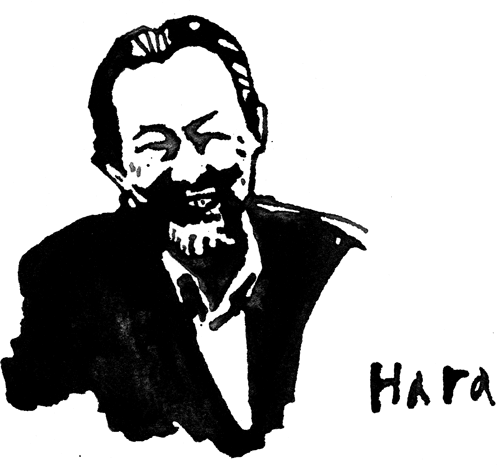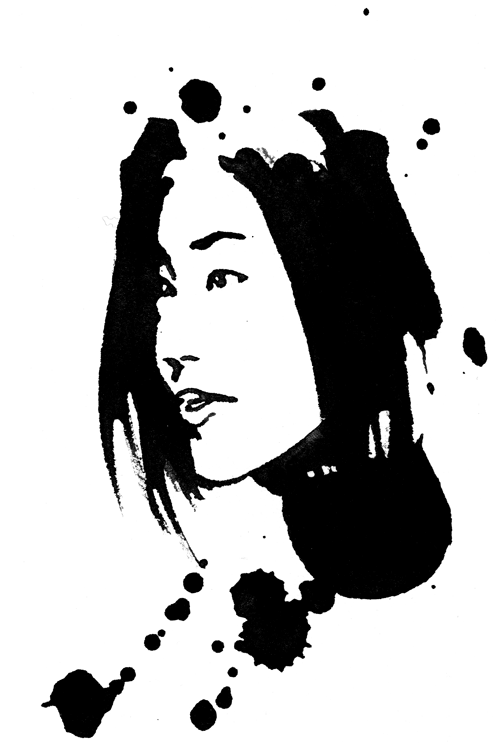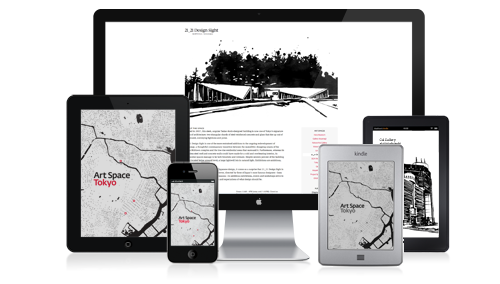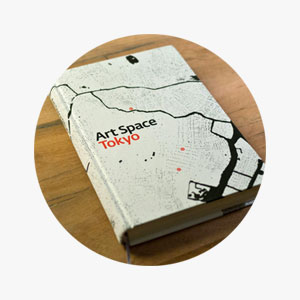Spontaneous Encounters & Permanent Installations
An interview with Toshio Hara & Yoko Uchida
Hara Museum of Contemporary Art, Shinagawa

TOSHIO HARA, director and president
Born in Tokyo in 1935, he graduated in political economics from Gakushuin University in 1958 and studied at Princeton University. He established the Foundation Arc-en-Ciel in 1977, the Hara Museum in 1979 and the Hara Museum ARC in 1988. He occupies senior positions in a variety of international committees, including MoMA in New York, Tate Gallery in London, the Museum of Contemporary Art, Tokyo and the 2008 Yokohama Triennale.
YOKO UCHIDA, associate director
Graduated from the Department of Life and Aesthetics at Showa Women’s University. She has organized and curated exhibitions of work by Zhou Tiehai Project — Placebo Swiss, Yasumasa Morimura, Yoshitomo Nara, Olafur Eliasson, Jason Teraoka, Henry Darger and Adriana Varejão.

What led you to start a contemporary art museum?
TH There were two reasons. First of all, the contemporary art world in Japan at the time was still small. It felt uncoordinated and there were no museums dedicated to contemporary art at all. Apart from the fact that my great-grandfather was a collector of antique art, at the time I had no real connection to art. But I was inspired to travel abroad, where I visited museums, met with artists and became friends with foreign collectors who gave their support to museums. Talking with them about all aspects of art, I began to understand and appreciate what they were doing. I wondered whether anything comparable was going on in Japan and figured that actually there wasn’t at all. Unlike antique art, though, contemporary art is about communicating with living artists, promoting them and creating spaces for their work. This kind of exchange and dialogue takes place on an international level, and that’s what I’m really interested in.
I also had a personal reason. I majored in economics, but after entering the business world and being fairly successful in it, I felt that there wasn’t much of a future for me there. I felt there was something more exciting that could be done.
What is the history of the museum building?
TH This used to be my grandfather’s residence. It was designed by Jin Watanabe and completed in 1938. After the war, old buildings were constantly torn down and replaced with ugly new structures. This building escaped that fate, but it was taken over by the US occupying forces1 and used as an officers’ residence for six or seven years. By the end of that period it was in pretty bad shape, crumbling and unfit for use. When it was finally returned to my family, it was left empty, and nobody knew what to do with it for almost ten years. My family considered tearing it down and building afresh at the very time I was thinking of starting a museum. Japanese museums at the time all tended to just occupy rented corners of bland office buildings. I had been visiting all types of museums in Europe, and I had noticed that many had been converted from private residences and had a garden. As it happened, this residence also had a garden, and the building had a unique character, so even though it was fairly run down, it occurred to me that it might work out well to fix it up and turn it into a museum.
What year did the Hara Museum begin collecting artworks?
THThat would have been about three years or so before the opening of the museum. I wasn’t a collector at all at the time, so it was my decision to open the museum that made me start collecting.
YUBut your great-grandfather and grandfather were collectors, weren’t they? In one way or other, I think you must have grown up exposed to culture, surrounded by high-quality artwork. It probably gave you a familiarity with art as a form of cultural and social support.
THI suppose that’s true. Although I didn’t actually consider doing that sort of thing myself, I was shown how one goes about preserving culture. For example, from a young age I learned to identify the artists who made the kakejiku2 we had in our tea ceremony room. It never felt odd to live surrounded by works of art.
What are your criteria in selecting artworks for your collection?
THIf you’ve studied art and have some experience with contemporary art, I think those criteria will already be quite well formed. But in my case, I pretty much began without knowing anything; I had no formalized criteria as such. It was a matter of what resonated with me and drew a response from me. It was fundamentally an extremely private, personal decision-making process. But to establish a museum with a meaningful collections behind it means developing an identity for both the museum and the collection, and communicating that to visitors. Pop art in the United States and the work of European artists in the 1960s laid the foundations for contemporary art there, which in turn influenced Japan. So I tried my best to gather the work of those kinds of artists.
YUThe first thing we did was to trace movements in the international contemporary art scene; we needed to understand the development of contemporary art from an historical perspective. At the very early stages of the collection, as you might expect, we were somewhat conscious that we were collecting the work of important artists from key periods in their careers, but also within larger, international and historical contexts.
THWe did as much as we could to develop personal exchanges with the artists, and we visited many of them in their studios and homes. People with an art history background might have been able to make judgments based purely on the fame of the artist or by the look of their work. But with us that was plainly impossible. If we didn’t actually go and meet the artists, we wouldn’t have been able to get to know the people behind the work, understand their thoughts and then decide if their work was appealing to us. If it was, then we would try to select pieces that were somehow representative among all of those that we liked.
What are your thoughts on the current state of Japanese museums?
THWe’re in the middle of a museum-building boom at the moment. These days, being involved with contemporary art is about prestige. In terms of how collecting Japanese contemporary art is viewed within society, there has been a 180-degree turnaround from how it was when this museum started. Nevertheless, I think that Japanese collectors are under this persistent illusion that foreign art is the best.
What kind of role do you think Japanese museums need to play in the future?
THThe role of contemporary museums is to discover young talent, groom it, promote it at the international level and create places for artistic exchange. Japanese museums have every opportunity for success on that front, but if the tendency to keep imitating foreign countries continues, then I think the Japanese museum world will end up being secondary and unable to assume any important role, no matter what people do.
How do you go about meeting artists? Do you make the rounds at events like art fairs and biennials?
THWe go to these events sometimes on an individual basis, sometimes for specific work-related projects. It’s surprising how important it is to show your face at these art fairs and biennials; you need to make sure that people know who you are and that you take the opportunity to see the works being produced everywhere.
YUThese events lead to spontaneous encounters. You end up bumping into artists whose work you saw somewhere. Perhaps you drop by their studio the next day and from there on, it may lead to them visiting the Hara Museum and a project ends up being realized out of that initial encounter.
What approach do you take to organizing and curating an exhibition?
YUI usually spend two or three years with artists planning the exhibition, and depending on the situation, I sometimes also get involved in the production process. Looking back now, it seems like the two years or so that I would spend with an artist could give me real insight into the previous fifteen years of their career. I worked in this way with Sophie Calle and Yasumasa Morimura. With Morimura-san, there were some works I was particularly attracted to. We spent a lot of time discussing the meaning of his practice in great detail. I organized two exhibitions of his work, and in both of those I was also involved in the production of the work itself.
What are the challenges of accommodating artworks in the Hara Museum’s unique spaces?
YUFor solo exhibitions, the artists we decide on are not haphazard choices: they are all artists who specifically want to show here, who are interested in the building’s space and history. The challenge is in achieving a correspondence between the interests and production methods outlined in the artist’s plan with the meaning, history and layout of the space. The recent Pipilotti Rist exhibition3 related her work with the history and character of this building, and I think something very special has emerged out of that exhibition. In that sense, this museum isn’t just a simple container: we try to put together exhibitions that could only happen here.
THRecently, almost all the exhibitions we have held have been sitespecific. This is something that the artists we have shown aspire to. It’s difficult for the Hara Museum to consider hosting traveling exhibitions because the contents have already been decided on and probably wouldn’t fit with this space.
Speaking of site-specific works, several of the exhibition rooms have permanent displays built into them. What was the reason for installing them like this?
THWe talked with the artists concerned and we thought the works were a perfect match for each location. For the artist, the sitespecific location becomes part of the uniqueness of the work, and for us it neatly solves the problem of the museum being perceived as just a temporary display box.
YUWhen we set up Miyajima-san’s piece Time Link in 1989, a lot of foreign curators and collectors showed interest in it. European and American galleries have long acted as representatives of their artists and provided paperwork that gives in-depth information on their work. However, in 1980s Japan, almost all galleries operated on a rental basis: artists could show their work if they paid money. With the exception of a few places, it wasn’t until the 1990s that commercial galleries like Gallery Koyanagi and Tomio Koyama Gallery established themselves and truly represented their artists’ interests. So we realized that we were getting great results by supporting young artists in this way.
THThere are a lot of artists who would like to make work for the permanent collection, but of course we have reached the limits of the space we have. Some people suggest we consider enlarging the museum space, but I don’t subscribe to this expansion mentality. I think museums each have an ideal, appropriate size. This building was a private house that was converted into a museum, and the current size is really the most appropriate for what it is.
How has contemporary art in Japan changed since you opened this museum?
THWhen I first got involved in contemporary art over thirty years ago, if any kind of trend appeared among foreign artists, people here would often hold Japanese artists up to that standard and say that this is how they should be. I wouldn’t go so far as to say it was foreign imitation, but artists were definitely making work by taking note of what was happening abroad, and I didn’t find that particularly interesting. That has gradually changed, and artists started to produce works that had real worth and could be appraised in their own terms.
Then, of course, there was the bubble period. From an artist’s perspective, the thriving economy of the 1980s must have been a good thing for some, but overall I think the adverse effects of the bubble outweighed the advantages. I don’t think it’s a very positive situation when the worth of an artwork or an artist is determined solely by monetary values or trends. Equally of course, it’s not good when nobody is buying art either, but I think that even if the economy isn’t exactly buoyant, it is more conducive to allowing proper collectors to appreciate the worth of an artist’s work. In short, looking back at the past thirty years, I would say the Japanese art world has matured a lot.
What kind of direction does the Hara Museum plan to take from here?
YUThe first ten years of this museum’s history were about establishing a presence within the Japanese art world and introducing young artists well enough to make people pay attention to our message. The next ten years were spent taking our exhibitions abroad and putting all our efforts into introducing Japanese contemporary art to the rest of the world. Our role probably shifted according to the circumstances. Now we have reached a stage where people around the world have more familiarity with contemporary Japan, but there is still more to do.
THAt a practical level, most of the work we have to do would be a question of deciding what exhibitions to hold, what kind of trends to pursue, searching for those trends, dispatching curators and negotiating with artists and collectors. In short, running a museum is really like a corporate activity. But this particular museum bases its activities more on ‘encounters,’ and when or where those encounters will happen and where they will take us are difficult to predict.

